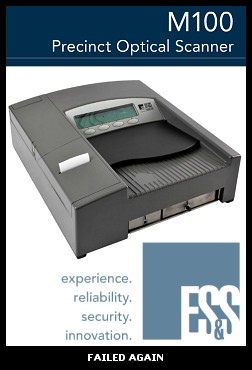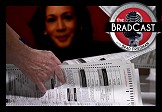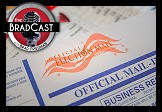By Ernest A. Canning and Brad Friedman
 We now have yet another ominous sign of trouble that may be on the horizon for this November's election. As if we needed yet another sign. And, once again, the concerns come via failures on paper ballot-based optical-scan computer tally systems.
We now have yet another ominous sign of trouble that may be on the horizon for this November's election. As if we needed yet another sign. And, once again, the concerns come via failures on paper ballot-based optical-scan computer tally systems.
Election officials in Genessee County, Michigan have acknowledged failures by the county's M-100 model optical-scan system, made by Election Systems and Software, Inc. (ES&S), during its Aug. 7 primary.
According to the county's Supervisor of Elections and Vital Records, Doreen D. Fulcher, the system experienced paper jams that resulted in ballots being fed through the system more than once. Fulcher, who also noted that there were a "number of ballots cast" that "didn't initially match poll book numbers," downplayed the scope of the problem. Flint's MLive, however, reported that the County Board of Canvassers were "still unraveling" the problem ten days after the election.
It is not the first time the M-100, set to be used in 32 different states again this November, has caused headaches for election officials and voters. The systems have a documented record of failing to count the same ballots the same way twice during pre-election testing. Nor is it the only optical-scan system made by ES&S, the largest e-voting vendor in the nation, that has failed time and again during elections.
As The BRAD BLOG previously reported, ballots obtained by the New York Daily News through a public records request revealed that ES&S op-scan systems used in a South Bronx precinct in 2010 failed to count some 70% of the paper ballots correctly in that year's primary election. In November's general election that year, some 54% of the ballots were mistallied at the same precinct.
The South Bronx used the newer ES&S model DS200, which the company confirmed could overheat, causing anywhere from 30% to 70% of the votes scanned by the machines to be erroneously discarded or erroneously counted. Thus, in the case of New York, that meant that tens of thousands of perfectly valid votes went uncounted, while thousands of "phantom votes" in races that voters hadn't intended to vote in at all were counted as valid.
The confirmation of the New York failure came almost two years after the election, once the newspaper was finally able to review the paper ballots by hand, under public records laws.
While Genessee County used the earlier ES&S Model M100, as we previously reported, the unreliability of opaque optical-scan computer tallying systems are, by no means, confined to the DS200 or, for that matter, to ES&S systems. Similar systems will once again be used across the entire country this November, to tally the Presidential election and all the races below it...either accurately or not...


 Sunday 'No Such Agreement' Toons
Sunday 'No Such Agreement' Toons How (and Why!) to 'Extend an Olive Branch' to MAGA Family Members Over the Holidays: 'BradCast' 11/21/24
How (and Why!) to 'Extend an Olive Branch' to MAGA Family Members Over the Holidays: 'BradCast' 11/21/24 'Green News Report' 11/21/24
'Green News Report' 11/21/24
 Former Federal Prosecutor: Trump Must Be Sentenced in NY Before Taking Office Again: 'BradCast' 11/20/24
Former Federal Prosecutor: Trump Must Be Sentenced in NY Before Taking Office Again: 'BradCast' 11/20/24 'Bullet Ballot' Claims, Other Arguments for Hand-Counting 2024 Battleground Votes: 'BradCast' 11/19/24
'Bullet Ballot' Claims, Other Arguments for Hand-Counting 2024 Battleground Votes: 'BradCast' 11/19/24 'Green News Report' 11/19/24
'Green News Report' 11/19/24 Trump Already Violating Law (He Signed!) During Transition: 'BradCast' 11/18/24
Trump Already Violating Law (He Signed!) During Transition: 'BradCast' 11/18/24 Sunday 'Into the Gaetz of Hell' Toons
Sunday 'Into the Gaetz of Hell' Toons Computer Security Experts Ask Harris to Seek Hand-Counts Due to Voting System Breaches: 'BradCast' 11/14/24
Computer Security Experts Ask Harris to Seek Hand-Counts Due to Voting System Breaches: 'BradCast' 11/14/24 'Green News Report' 11/14/24
'Green News Report' 11/14/24 Trump Criminal Cases Fade, as GOP 'Does Not Believe in Rule of Law': 'BradCast' 11/13/24
Trump Criminal Cases Fade, as GOP 'Does Not Believe in Rule of Law': 'BradCast' 11/13/24 Climate Advocates Brace for Fight With Trump 2.0: 'BradCast' 11/12/24
Climate Advocates Brace for Fight With Trump 2.0: 'BradCast' 11/12/24 Let It All Out: 'BradCast' 11/11/24
Let It All Out: 'BradCast' 11/11/24 Not All Bad: Abortion Rights Won Big (Almost) Everywhere: 'BradCast' 11/7/24
Not All Bad: Abortion Rights Won Big (Almost) Everywhere: 'BradCast' 11/7/24 U.S. CHOOSES CONVICTED CRIMINAL, ADJUDICATED RAPIST: 'BradCast' 11/6/24
U.S. CHOOSES CONVICTED CRIMINAL, ADJUDICATED RAPIST: 'BradCast' 11/6/24 ELECTION DAY 2024: Tea Leaves, Probs for Voters, What's Next: 'BradCast' 11/5/24
ELECTION DAY 2024: Tea Leaves, Probs for Voters, What's Next: 'BradCast' 11/5/24 'Closing Arguments' for Undecideds, Third-Party Voters: 'BradCast' 11/4/24
'Closing Arguments' for Undecideds, Third-Party Voters: 'BradCast' 11/4/24 The GOP 'Voter Fraud' Before the Storm: 'BradCast' 10/31/24
The GOP 'Voter Fraud' Before the Storm: 'BradCast' 10/31/24
 VA GOP VOTER REG FRAUDSTER OFF HOOK
VA GOP VOTER REG FRAUDSTER OFF HOOK Criminal GOP Voter Registration Fraud Probe Expanding in VA
Criminal GOP Voter Registration Fraud Probe Expanding in VA DOJ PROBE SOUGHT AFTER VA ARREST
DOJ PROBE SOUGHT AFTER VA ARREST Arrest in VA: GOP Voter Reg Scandal Widens
Arrest in VA: GOP Voter Reg Scandal Widens ALL TOGETHER: ROVE, SPROUL, KOCHS, RNC
ALL TOGETHER: ROVE, SPROUL, KOCHS, RNC LATimes: RNC's 'Fired' Sproul Working for Repubs in 'as Many as 30 States'
LATimes: RNC's 'Fired' Sproul Working for Repubs in 'as Many as 30 States' 'Fired' Sproul Group 'Cloned', Still Working for Republicans in At Least 10 States
'Fired' Sproul Group 'Cloned', Still Working for Republicans in At Least 10 States FINALLY: FOX ON GOP REG FRAUD SCANDAL
FINALLY: FOX ON GOP REG FRAUD SCANDAL COLORADO FOLLOWS FLORIDA WITH GOP CRIMINAL INVESTIGATION
COLORADO FOLLOWS FLORIDA WITH GOP CRIMINAL INVESTIGATION CRIMINAL PROBE LAUNCHED INTO GOP VOTER REGISTRATION FRAUD SCANDAL IN FL
CRIMINAL PROBE LAUNCHED INTO GOP VOTER REGISTRATION FRAUD SCANDAL IN FL Brad Breaks PA Photo ID & GOP Registration Fraud Scandal News on Hartmann TV
Brad Breaks PA Photo ID & GOP Registration Fraud Scandal News on Hartmann TV  CAUGHT ON TAPE: COORDINATED NATIONWIDE GOP VOTER REG SCAM
CAUGHT ON TAPE: COORDINATED NATIONWIDE GOP VOTER REG SCAM CRIMINAL ELECTION FRAUD COMPLAINT FILED AGAINST GOP 'FRAUD' FIRM
CRIMINAL ELECTION FRAUD COMPLAINT FILED AGAINST GOP 'FRAUD' FIRM RICK SCOTT GETS ROLLED IN GOP REGISTRATION FRAUD SCANDAL
RICK SCOTT GETS ROLLED IN GOP REGISTRATION FRAUD SCANDAL VIDEO: Brad Breaks GOP Reg Fraud Scandal on Hartmann TV
VIDEO: Brad Breaks GOP Reg Fraud Scandal on Hartmann TV RNC FIRES NATIONAL VOTER REGISTRATION FIRM FOR FRAUD
RNC FIRES NATIONAL VOTER REGISTRATION FIRM FOR FRAUD EXCLUSIVE: Intvw w/ FL Official Who First Discovered GOP Reg Fraud
EXCLUSIVE: Intvw w/ FL Official Who First Discovered GOP Reg Fraud GOP REGISTRATION FRAUD FOUND IN FL
GOP REGISTRATION FRAUD FOUND IN FL



















 Some good-ish news late tonight for Florida voters, and more bad-ish news for Republican Gov. Rick Scott and friends, as
Some good-ish news late tonight for Florida voters, and more bad-ish news for Republican Gov. Rick Scott and friends, as  One of the most notorious election officials in the nation may be mercifully retiring at the end of this year, but that hasn't stopped her from attempting to block citizens hoping to oversee the accuracy of their own elections in one of the most right-leaning counties in Wisconsin, following one of the most contentious elections of the year and certainly in state history.
One of the most notorious election officials in the nation may be mercifully retiring at the end of this year, but that hasn't stopped her from attempting to block citizens hoping to oversee the accuracy of their own elections in one of the most right-leaning counties in Wisconsin, following one of the most contentious elections of the year and certainly in state history. Well, this sounds familiar, and for good reason...
Well, this sounds familiar, and for good reason... Florida Governor Rick Scott's attempted purge of "potential non-citizen" voters --- a purge which Scott's Republican predecessor Gov. Charlie Crist
Florida Governor Rick Scott's attempted purge of "potential non-citizen" voters --- a purge which Scott's Republican predecessor Gov. Charlie Crist 



 We had a jam-packed hour on today's BradCast on
We had a jam-packed hour on today's BradCast on  Only a handful of Americans understand what really took place inside a Tallahassee, FL federal courtroom on Wednesday, June 27, 2012, thanks to the skewed reality presented by mainstream corporate media coverage of the latest ruling to affect Florida's attempted purge of alleged "non-citizen" voters.
Only a handful of Americans understand what really took place inside a Tallahassee, FL federal courtroom on Wednesday, June 27, 2012, thanks to the skewed reality presented by mainstream corporate media coverage of the latest ruling to affect Florida's attempted purge of alleged "non-citizen" voters.
 Rep. Ted Deutch (D-FL-19) joined me live on today's BradCast on
Rep. Ted Deutch (D-FL-19) joined me live on today's BradCast on 
 Perhaps we should call it the David Gregory Technique, since the dreadful Meet the Press host seems to use it, and little more, week in and week out during his usually useless interviews with public officials.
Perhaps we should call it the David Gregory Technique, since the dreadful Meet the Press host seems to use it, and little more, week in and week out during his usually useless interviews with public officials. Last week, after
Last week, after 













